Proposed Assumptions
Modeling the “Real” World
The “real” world is different from the one that fits the common assumptions. In the real world, there are a limitless number of factors that affect the propensity for crime. The real world is complex and chaotic. The proposed assumptions may seem to be unworkable at first, but a more realistic model of reality has the advantage of being capable of making more accurate predictions. The proof is in the pudding.
Proposed Assumptions
- Limited -> Limitless Number of Causes
- True Score -> Intra-Individual Variability
- Taxonomy -> Massively Multivariate, Complex, and Normal
- Dichotomous -> Ratio Level
- Null -> Additive Effects
- Constant -> Variable Sanctioning
- Linearity -> Non-Linearity
- The Neutral Default Assumption
- The Capacity Assumption
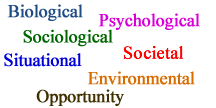
Crime has a Limitless Number of Causes
Although the current assumption is that there are a limited number of reasons that people commit crimes, the evidence suggests that there are a limitless number of causes of criminal behavior. These causes can be found at the biological, psychological, sociological, and environmental levels. In addition, the situation plays an important role. Several hundred crime correlates have been identified and the missing heritability problem suggests that perhaps hundreds of genes are involved.
It is assumed that crime is a function of a limitless number of factors.
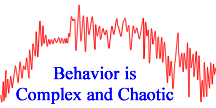
Behavior is Complex and Chaotic
One of the common measurement assumptions is that there is a “true score” that represents a stable trait. The sciences of complexity and chaos assume that behaviors of large groups of organisms can have unusual and often unpredictable dynamics. This chaotic dynamic pattern occurs with many different groups including brain cells, ants, and human beings. Rather than assume a “true score,” which is a static factor, it would be more accurate to assume that human behavior has complex and chaotic dynamics.
It will be assumed that complex and chaotic dynamics are the rule.

The Typology Assumption
Some theories begin with the assumption that there are distinct types of criminals. Moffitt’s (1993) life course taxonomy is a notable example. These theories posit that there are meaningful differences between groups of people. While this is an appealing simplification, it is an untenable position in a continuous world.
Criminologists need to deal with a continuous world where there are no clear lines of demarcation between one group and another.
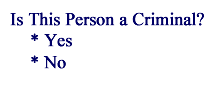
The Dichotomous Assumption
Many statistical analyses begin with the assumption that criminality can be represented as a dichotomous variable. With the dichotomous assumption, a person is either a criminal or they are not. While this black and white model is statistically convenient, it does not represent reality.
In reality, the world is not black and white. The world is more of a technicolor process.
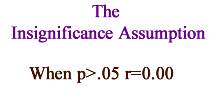
The Insignificance Assumption
One of the assumptions made by scientists is that insignificant factors do not matter. This is called the null hypothesis. It is conventionally assumed that when p>.05, there must be a null or “no” relationship between the variables. That is, the correlation between the variables is assumed to be zero. This would seem to be an erroneous assumption. Take a single case as a counter-example. The missing heritability paradox arises because most of the relationships between individual genes and criminal behavior are extremely small and insignificant. These insignificant relationships are not zero however, because the combinations of the individual genetic contributions add up to explain 50% of the variance at the genome level.
Criminologists need to deal with the possibility that the influences of massive numbers of insignificant factors combine to create substantial influences on the propensity for criminal behavior.
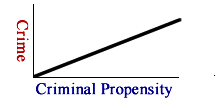
The Linearity Assumption
There is a perception that the relationship between the propensity for crime and the crime rate is linear. That is, a one unit change in criminal propensity should produce one unit of change in the crime rate. In a normal world, this is an erroneous assumption.
Criminologists need to deal with a world where nonlinearity is the rule.
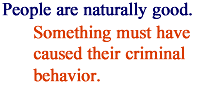
The Non-Criminal Default Assumption
There is a common assumption that people naturally avoid crime and that something “causes” people to be criminals. For example, strain theories posit that people are “pressured into crime.” This assumption ignores the many factors that lead to non-criminal behavior.
Criminologists need to deal with a world where both positive and negative factors affect the propensity for crime.
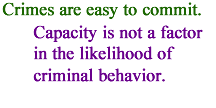
The Null Effects of Capacity Assumption
There is a common assumption that crimes are easy to commit and easy to avoid. Therefore, the capacity for crime and non-crime is not a factor that needs to be considered. This may be true in a general sense, but this assumption ignores the distinct possibility that the capacity for crime and non-crime is a significant factor affecting crime rates over the life course.
Criminologists need to deal with a world where the capacity for crime is something to be considered.
